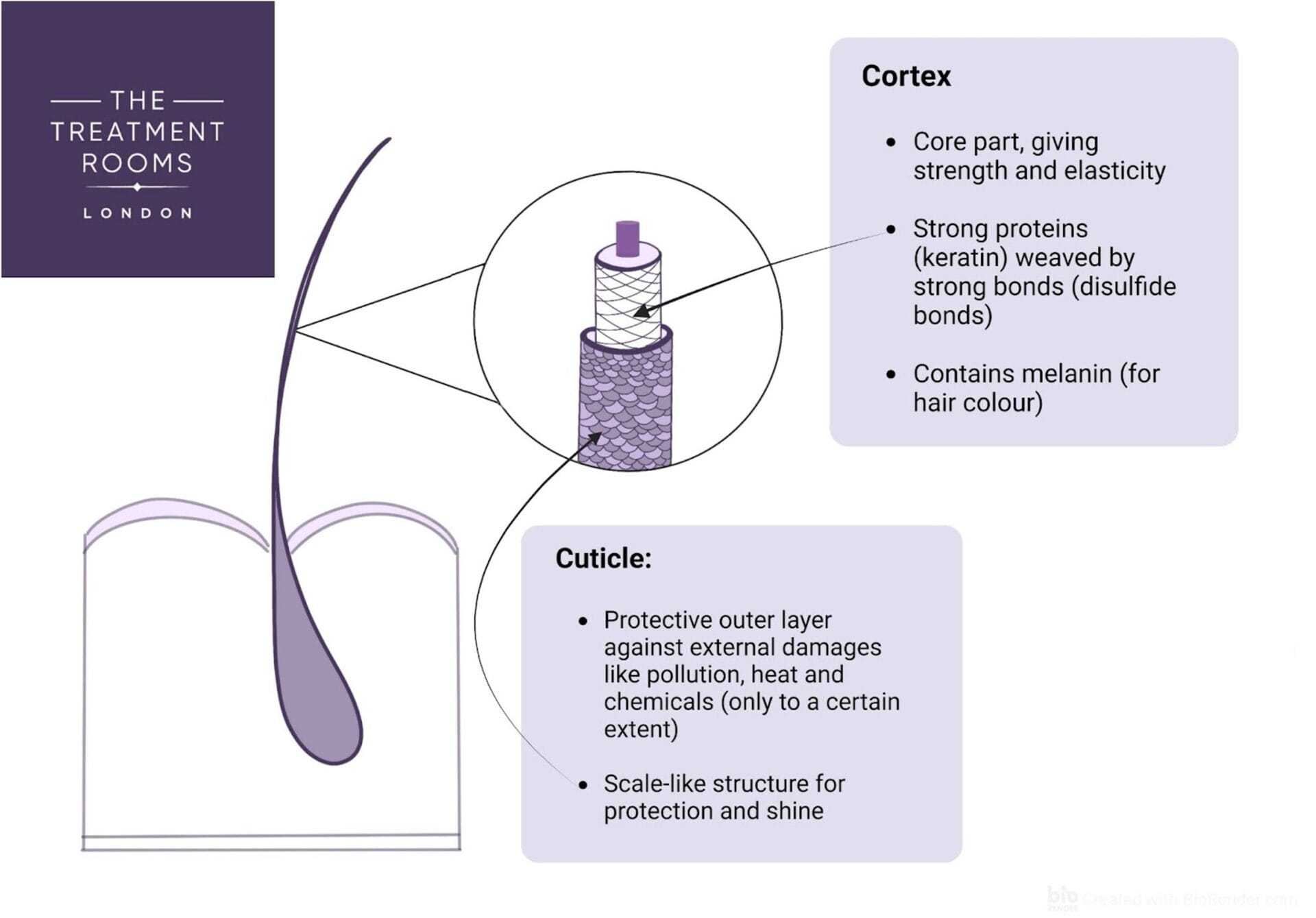Quick Summary: Hair Brushing and Hair Growth
Brushing’s Real Benefits: While brushing doesn’t directly stimulate hair growth, it aids in distributing scalp oils and enhancing circulation, which can indirectly support hair health.
The Risks of Over-Brushing: Brushing your hair too hard or too often can actually cause more harm than good, leading to damaged hair and more hair falling out. It’s all about finding the right balance and being gentle with your hair care.
Hair Anatomy: Understanding the structure of hair, including the protective cuticle and the cortex that provides strength, highlights the importance of gentle brushing to maintain hair integrity.
Choosing Between Brush or Comb?: The decision between using a brush or comb should consider hair curl, desired style, and personal preference to avoid damaging the hair.
Incorporating Brushing Into Your Routine: A balanced approach to brushing, along with a nutritious diet and proper scalp care, promotes overall hair health. For persistent hair or scalp issues, professional consultation is recommended.
Key Takeaway: Effective hair care extends beyond brushing, encompassing nutrition, scalp health, and gentle grooming practices. Recognising when to seek expert advice is crucial for maintaining optimal hair health.
In this article, we explore the truth behind hair brushing and its impact on hair health. We’ll also tackle some common questions about this practice and provide tips on avoiding hair damage from incorrect brushing techniques. Join us as we comb through the facts, offering insights and advice for maintaining your hair at its best.
Does Brushing Really Stimulate Hair Growth?
The short answer: no. Science hasn’t yet found evidence that brushing alone can make hair grow. Hair growth mainly hinges on genetics, your health, and what you eat.
That being said, brushing gently and regularly does play a supportive role in hair health by evenly spreading the scalp’s natural oils down each strand, as well as boosting circulation. This not only boosts shine, but also minimises breakage by keeping hair moisturised and flexible, which is important for keeping hair long and healthy.1
It is important to beware of overdoing it. While gentle brushing is beneficial, aggressive brushing can cause more damage than good. This includes brushing wet hair, pulling too hard on the scalp, and not detangling strands properly.2
The Science Behind Hair and Scalp
Before diving deeper, let’s explore the basics of hair anatomy.
Hair isn’t just a simple thread sprouting from our scalp; it’s a complex structure with each part playing a specific role. These complex structures are significantly influenced by how we care for them.
The strength of our hair largely depends on its two main shaft components: the cortex and the cuticle.1 These parts work together to protect and maintain the integrity of your hair through everything life throws at it, from brushing to styling to exposure in the sun.
The Cuticle: Your Hair’s Shield
- The hair’s first line of defence. The cuticle’s layers of tiny, overlapping scales (similar to roof slates) not only protect the inner parts of the hair against damage from external factors, but also plays a significant role in how shiny and smooth your hair looks and feels because of its reflective mirror-like properties.
The Cortex: The Core of Strength and Colour
- Going deeper, you’ll find the cortex. Thanks to durable keratin proteins bonded tightly together, the cortex is a source of strength and elasticity. It also contains melanin, the pigment responsible for your hair’s colour and protecting your strands from UV damage.

Why Proper Brushing Matters
Given this intricate structure, it is clear to see why hair needs to be handled with care. To protect your strands, consider the following:
- Protect the Cuticle: Rough brushing can damage this protective layer, leading to weakened, brittle hair.
- Preserve the Cortex: Harsh brushing can stretch and break the cortex’s critical bonds, damaging the hair’s integrity and appearance.
Brushing vs. Combing: What’s Better for Your Hair?
The debate between brushing and combing is longstanding, with each method having its own pros and cons based on your hair type. At our clinic, we believe in what works best for you.
Brushing, particularly with natural bristle brushes, is promoted for its ability to distribute scalp oils throughout the hair effectively.
In contrast, combing with wide-toothed combs is often recommended for detangling, especially for curly or textured hair, in order to minimise breakage.
Choosing the Best Brush/Comb for Your Hair Type:
Choosing between brushing and combing hinges on:
- Your hair curl and texture
- The style you want to achieve
- Personal preference
For example, those with finer hair might opt for brushing to add volume, while those with curly hair might choose combing to detangle without altering their natural curl pattern and creating frizz. For more detailed guidance on selecting the right tool for your hair type and desired look, consider exploring comprehensive resources, like this article by The Independent.
How to Integrate Hair Brushing into Your Hair Care Routine
We highly suggest adding regular, gentle hair brushing to your routine if it isn’t part of it already. Here’s how to do it effectively:
- Choose the Right Tool: Look for one with soft, flexible bristles to gently detangle without pulling too hard on your hair.
- Detangle Gently: Try and make gentle detangling part of your routine. Begin detangling from the ends and work your way up to the roots, minimising stress on hair fibres.
- Distribute Natural Oils: Finish with gentle full brush strokes from scalp to ends to spread natural oils, enhancing hair’s shine and health.
- Keep It Clean: Keep your brush free of hair, oils, and product residue to prevent them from being transferred back onto your hair.
- Brush on Dry Hair: Since wet hair is more prone to damage, brush when your hair is dry or slightly damp.
- Protect and Nourish: Apply leave-in conditioners or serums to protect the cuticle, especially if you use heat styling tools often.
At The Treatment Rooms, we place emphasis on good hair grooming habits, as research shows that “weathering” of hair, influenced by environmental factors like UV rays, humidity, and chemical treatments, alongside your grooming practices, can impact hair growth, texture, and density.1 Understanding your hair’s structure and the importance of gentle care can lead to healthier, more vibrant hair. This might seem like a big task, but making time for hair care, perhaps as a calming pre-sleep routine, can be a small, yet significant step towards nurturing your hair’s natural health.
Scalp Health and Hair
The scalp, the bedrock upon which hair sits, significantly influences hair health. Any issues affecting the scalp, from sensitive conditions like scalp psoriasis or infections to more general concerns like hair thinning or loss, can directly affect hair growth and quality. It’s essential to prioritise scalp health as part of your hair care regimen, as a well-cared-for scalp fosters a healthy environment that promotes hair growth.
If you’re experiencing hair loss or scalp problems, we strongly recommend consulting with your GP. They can offer guidance on the best treatment options tailored to your needs, from hair growth stimulants like Minoxidil and Finasteride to expert consultations with transplant surgeons, like our team. Remember, the first step towards addressing your hair concerns begins with understanding and caring for your scalp.
Tips To Further Enhance Your Hair Health
- Nutrition is Key: A well-balanced diet rich in essential nutrients significantly impacts hair health. Prioritise protein, iron, zinc, omega-3 fatty acids, and vitamins A, B complex, C, and E.3 These nutrients support hair follicle health, promote hair growth, and protect against hair loss.
- Natural Remedies: Incorporate natural oils into your hair care routine. Coconut oil can moisturise and reduce protein loss from hair. Black seed oil, known for its healing properties, can soothe scalp conditions and promote growth. Rosemary oil is another excellent choice, shown to enhance hair growth similarly to minoxidil, a common hair growth treatment.
- Scalp Massage: Regular scalp massages increase blood circulation to hair follicles and can promote hair growth as a result.4 This practice not only nurtures your scalp but also offers a relaxing self-care moment. Use gentle, circular motions with your fingertips or a soft-bristled brush.
Integrating these practices into your daily routine can lead to stronger, healthier hair. Remember, consistency is key if you want to see results.
Conclusion
Concluding this exploration, we see that while brushing may not directly cause hair to grow, it is vital for maintaining hair and scalp health. If you’re experiencing unusual hair loss, scalp discomfort, or texture changes, please get in touch with a dermatologist or trichologist.
A balanced approach to hair care with an emphasis on gentle hair grooming, nutrition, and scalp health, is a way to boost not only your hair’s condition, but also your confidence. For any concerns, our clinic is here with expert advice and personalised solutions to guide you toward your best hair health.
References
- Monselise, A., Cohen, D. E., Wanser, R., & Shapiro, J. (2017). What Ages Hair?. International journal of women’s dermatology, 3(1 Suppl), S52–S57. https://doi.org/10.1016/j.ijwd.2017.02.010
- Goldenhart AL. Assisting patients with personal hygiene [Internet]. StatPearls [Internet]. U.S. National Library of Medicine; 2022 [cited 2024 Mar 27]. Available from: https://www.ncbi.nlm.nih.gov/books/NBK563155/
- Wall, D., Meah, N., Fagan, N., York, K., & Sinclair, R. (2022). Advances in hair growth. Faculty reviews, 11, 1. https://doi.org/10.12703/r/11-1
- Koyama, T., Kobayashi, K., Hama, T., Murakami, K., & Ogawa, R. (2016). Standardized Scalp Massage Results in Increased Hair Thickness by Inducing Stretching Forces to Dermal Papilla Cells in the Subcutaneous Tissue. Eplasty, 16, e8. Available from: https://www.ncbi.nlm.nih.gov/pmc/articles/PMC4740347/
- Hair anatomy diagram edited with BioRender.com
Share:
Authored by
Reviewed by
Book a Consultation
Related Blogs
Ronnie Vint – Love Island Hair Transplant: Before, After, And His Hairline
April 14, 2025
Ronnie Vint, a former footballer and current TV personality, appeared on the 2024 season of “Love Island”…
Prince Harry Hair Loss: Speculations, Treatments, and Possible Transplant Options
April 13, 2025
Prince Harry, the Duke of Sussex and beloved royal-turned-global humanitarian, has sparked global curiosity over his ever-evolving…
Gordon Ramsay Hair Transplant: Before, After, and His New Hairline
April 12, 2025
Gordon Ramsay, the fiery Michelin-starred chef, restaurateur and TV personality, has swapped his receding temples for a…
Elon Musk Hair Transplant: Before, After and His New Hairline
April 11, 2025
Elon Musk, the billionaire behind Tesla and SpaceX, is a well known figure for his innovations and…
Xherdan Shaqiri Hair Transplant: Before, After, and His New Hairline
April 10, 2025
Xherdan Shaqiri is a Swiss international football star best known for his stints at Bayern Munich, Stoke…
Ariana Grande Hair Loss: Prevention, Styling Secrets, and Hypothetical Transplant Solutions
April 10, 2025
Ariana Grande, the global pop sensation renowned for her signature high ponytail and bold hairstyles, has openly…
Daniel Craig Hair Transplant: Before, After and His Hairline
April 10, 2025
Daniel Craig, the world-famous English actor who gained international fame as the fast-paced, debonair James Bond, has…
Rob Brydon Hair Transplant: Before, After, and His New Hairline
April 8, 2025
Rob Brydon, the beloved Welsh comedian and Gavin & Stacey star, has traded his receding hairline for…
Has Perez Hilton had a hair transplant? All You Need to Know
April 2, 2025
Perez Hilton is a familiar face in the media. He is known for his work as a…











